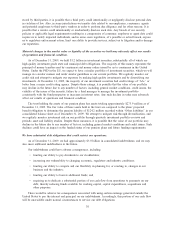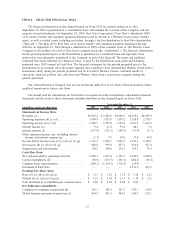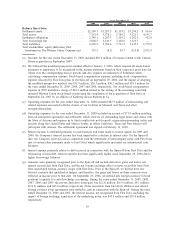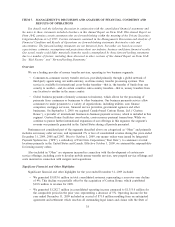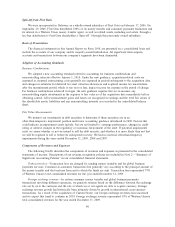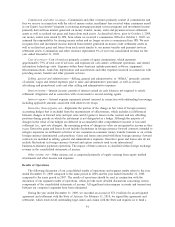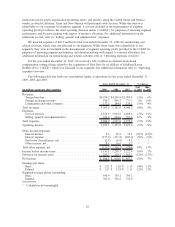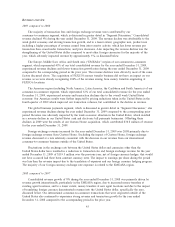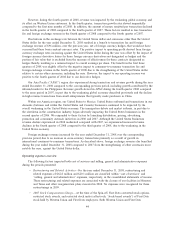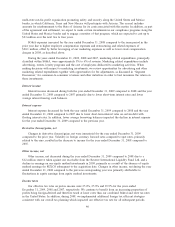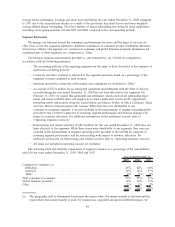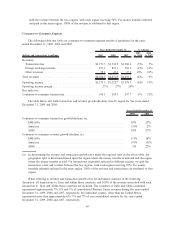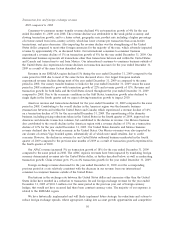Western Union 2009 Annual Report Download - page 54
Download and view the complete annual report
Please find page 54 of the 2009 Western Union annual report below. You can navigate through the pages in the report by either clicking on the pages listed below, or by using the keyword search tool below to find specific information within the annual report.Spin-off from First Data
We were incorporated in Delaware as a wholly-owned subsidiary of First Data on February 17, 2006. On
September 29, 2006, First Data distributed 100% of its money transfer and consumer payments businesses and
its interest in a Western Union money transfer agent, as well as related assets, including real estate, through a
tax-free distribution to First Data shareholders (“Spin-off ”) through this previously owned subsidiary.
Basis of Presentation
The financial statements in this Annual Report on Form 10-K are presented on a consolidated basis and
include the accounts of our company and its majority-owned subsidiaries. All significant intercompany
accounts and transactions between our company’s segments have been eliminated.
Adoption of Accounting Standards
Business Combinations
We adopted a new accounting standard related to accounting for business combinations and
noncontrolling interests effective January 1, 2010. Under the new guidance, acquisition-related costs are
expensed as incurred, restructuring costs generally are expensed in periods subsequent to the acquisition date,
and changes in estimates for deferred tax asset valuation allowances and acquired income tax uncertainties
after the measurement period, which is one year or less, impact income tax expense in the period of change.
For business combinations achieved in stages, the new guidance requires that we re-measure any
noncontrolling equity investments in the acquiree to fair value as of the acquisition date immediately before
obtaining control. All re-measurement gains and losses are recognized in earnings and the total fair values of
the identifiable assets, liabilities and any noncontrolling interests are recorded in the consolidated balance
sheet.
Fair Value Measurements
We monitor our investments in debt securities to determine if these securities are in an
other-than-temporary impairment position under new accounting guidance introduced in 2009. Factors that
could indicate an impairment exists include, but are not limited to: earnings performance, changes in credit
rating or adverse changes in the regulatory or economic environment of the asset. If potential impairments
exist, we assess whether or not we intend to sell the debt security, and whether it is more likely than not that
we will be required to sell it, before its anticipated recovery. We had no material other-than-temporary
impairments during the years ended December 31, 2009, 2008 and 2007.
Components of Revenues and Expenses
The following briefly describes the components of revenues and expenses as presented in the consolidated
statements of income. Descriptions of our revenue recognition policies are included in Note 2—“Summary of
Significant Accounting Policies” in our consolidated financial statements.
Transaction fees—Transaction fees are charged for sending money transfers and for global business
payments services. Consumer-to-consumer transaction fees generally vary according to the principal amount of
the money transfer and the locations from and to which the funds are sent. Transaction fees represented 79%
of Western Union’s total consolidated revenues for the year ended December 31, 2009.
Foreign exchange revenue—In certain consumer money transfer and global business payments
transactions involving different currencies, we generate revenue based on the difference between the exchange
rate set by us to the customer and the rate at which we or our agents are able to acquire currency. Foreign
exchange revenue growth has historically been primarily driven by growth in international cross-currency
transactions. As a result of the acquisition of Custom House, our foreign exchange revenues have increased
and we expect this trend to continue in 2010. Foreign exchange revenue represented 18% of Western Union’s
total consolidated revenues for the year ended December 31, 2009.
40


